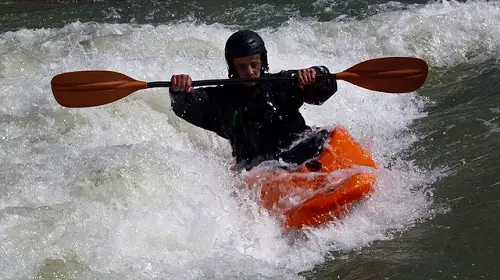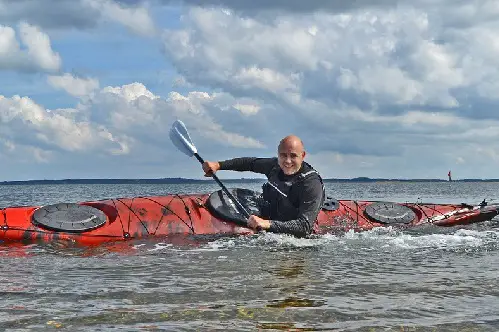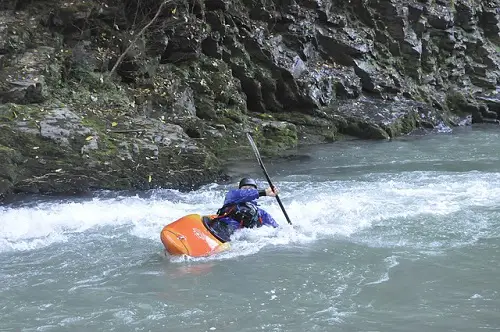Kayaking can be a fun and exciting sport. Still, many people worry about the safety of this activity. One of their biggest concerns is to get in a kayak and suddenly flip over to end up in the water.
I also used to have questions such as: Is it likely to happen? What should you do if it happens? How to prevent it? Flipping over in a kayak isn’t the end of the world, but it can seem relatively scary. So here’s what you should know about it!
Contrary to what most people think, kayaks are generally hard to flip over. They are stable enough to prevent you from capsizing in calm and flat water. However, a kayak can easily tip over in moving water. You can also learn techniques to keep your balance while paddling and reduce the risk of flipping in the water.

Before starting a new activity, you should know what to expect. Kayaking isn’t particularly dangerous, but you will eventually tip over whether you want it or not.
That’s why it’s essential to understand what to do when it happens and make everything in your power to prevent it. Now let’s dive into the details to help you have a good time on the water!
How Easily Does A Kayak Flip?
Although most kayaks are stable, it’s not always the case. There are many factors to consider on this type of boat to understand whether it’s easy or not to flip it over. So here’s what you should analyze before heading out on the water.
Type Of Kayak.
Some kayaks are more likely to flip over than others. With all the different models available, the level of stability will change from one boat to another. That’s why it’s an essential element to keep in mind.
There are 5 main types of kayak:
- Ocean.
- Whitewater.
- Touring.
- Sit-On-Top.
- Inflatable.
Each of them has a specific design for a given purpose. But even in the same category, every kayak has a unique construction.
For example, my dad has multiple boats of the same type (for whitewater river paddling), and some can tip over easily while others don’t. That’s why the kayak you plan to use will influence the risk of capsizing.
Now you may wonder what makes one more stable than another. Well, the built is the main factor to consider.
Long and narrow kayaks are generally easier to flip over than short and wide ones. A flat or pontoon hull can also increase the stability of a boat.
Then, it will vary a lot from one design to another. For instance, there’s a difference between sit-inside and sit-on-top kayaks.
Sit-on-top models have a design meant for recreational use, so they are usually harder to capsize. On the other hand, an enclosed cockpit gives you more control to stabilize your boat with your legs and hips.
If you’re looking for a kayak that can’t flip over, it, unfortunately, doesn’t exist. But sit-on-top recreational, inflatable, and fishing models generally provide more stability. So they are the best options to prevent you from capsizing as you start learning how to paddle.
Water Conditions.
Another important consideration is the circumstances in which you plan to kayak. Two main elements will influence your stability on the water: The Place & The Weather.
Choosing a safe and predictable environment will help you to avoid flipping over. That’s why lakes and calm rivers are great places to start for beginners. A kayak is not likely to capsize on flat and still water unless you make a mistake or do it deliberately.
In the ocean, you have to deal with tides and waves. In fast-flowing rivers, there are rapids, powerful currents, and many obstacles to avoid. That’s why sea and whitewater kayaking makes you more at risk of tipping over.
The weather will also influence how safe and calm the water is. Strong winds and thunderstorms can make any type of environment dangerous to navigate. Thus, it’s essential to consider the meteorological conditions before kayaking.
Your Kayaking Skills.
The last factor you should analyze is the experience you have with this water sport. An expert will need much more to flip over in a kayak than a complete beginner. For example, my dad practically never capsizes, but it does occasionally happen to me.
What about my friends who are just getting started? They generally spend more time in the water than in their boat. So you should be ready to get wet if you don’t have any paddling skills yet.
Overall, kayaks do not flip over easily. But the risk of capsizing will vary according to many elements. The kayak design, water conditions, and your experience can all influence your stability on paddling adventures.

Is It Easier To Flip A Kayak or Canoe?
Compared to other types of boats, the kayak will generally tip over more easily. For example, a canoe is more stable mainly because of its long and wide hull. That’s why the risk of capsizing is higher in a kayak than in a canoe.
However, a smaller boat provides better control. It’s also faster on the water and easier to perform a roll when it flips over. Although a kayak isn’t the most stable boat, it has other advantages, and it doesn’t tip over that easily.
How To Prevent Your Kayak From Tipping Over?
Kayaks aren’t easy to capsize, but it will eventually happen to you at some point if you use one. Otherwise, there would be no fun and adrenaline in a water sport where the boat can’t flip over.
Nonetheless, it’s understandable that people want to avoid it as much as possible. Apart from choosing a stable type of kayak and the right water conditions, you can also improve your paddling skills.
Advice To Keep You From Capsizing!
Indeed, there are a few different ways to prevent your kayak from flipping over. First of all, it’s essential to find your balance on the water. Make sure everything is well adjusted so you can have control over your boat.
If you carry extra gear, food, or anything else, it’s crucial to distribute the weight evenly. Once your boat is balanced, I highly recommend leaning on both sides to understand how stable your kayak is.
With that in mind, you will be much more confident while paddling. Knowing your boat limits and capacity is helpful to figure out what you can or can’t do. Testing how it responds to your lower body movements will also decrease the risk of capsizing later on.
How Do I Stop My Kayak From Flipping Over?
Once you’ve taken all the precautions to improve your stability on the water, you still have to work on your technique. The best solution to not flip over while kayaking is to use your paddle as support.
With a single stroke, you can stop your boat just before it capsizes. In kayak terms, we call this recovery method the low or high brace. Here are more details about each of those paddling techniques.
Low Brace.
When you lose your balance in a kayak, you need a quick way to put yourself back upright. That’s where the first solution to keep you from capsizing comes into play: The low brace.
Simply put, it consists of pushing on the water with your paddle for momentary support. It will help you stop the boat as it starts tipping over.
How To Perform It?
The low brace isn’t too complicated to put into practice. First of all, you have to place your arms into a push-up position with the paddle in your hands. When your kayak is about to flip over, use the backside of your paddle blade to smack the water.
In other words, you will brace yourself not to capsize. But this paddling technique isn’t as simple as it might sound. You can quickly end up in the water if you lean too much, don’t restore balance fast enough, or miss any other part of the process.
That’s why you must practice the low brace a lot before using it efficiently and reliably. As stated in this article (https://paddling.com/learn/kayak-braces-high-and-low-braces/) from Paddling.com “The key to finishing the brace is to drop your head and body towards the water to lower your center of gravity as you flatten out your kayak.”
With this information and the video a little bit further below, you should be all set to give it a try. Now it’s time to hop in your boat and start working on this essential recovery technique.
High Brace.
The second option is an upgrade of the low brace. It’s the same principle, but the technique is slightly different. This other similar recovery method also gives you temporary support to level off your kayak.
How To Perform It?
For the high brace, you need to place your arms in a pull-up position with the paddle as low as possible in your hands. As the kayak starts to flip over, you smack the water with the power face blade. You can then drop your head and upper body toward the water to flatten out the boat.
With the high brace technique, you have much more power. So you can stop your kayak from flipping over, even when it’s almost upside down. The only drawback with this method is that your elbow is at risk of injury if you use it too often.
How To Stop Your Kayak From Capsizing – Braces Video
As visual support, here’s a video that shows both techniques. Watching it will give you a better idea of what they look like and how to perform each of them. Good listening!
Which One Should You Choose?
The perfect solution would be to master and use both techniques. However, it’s not as easy as it seems. I prefer the high brace mainly because it feels more natural to me, and you can use it in pretty much any situation.
On the other hand, I should probably perform the low brace when it’s more appropriate to keep my elbow safe and sound. But smacking the water with the power face of my paddle is now an automatism.
So if you’re just getting started, it’s recommended to learn and apply both methods. Otherwise, you might end up like me with the bad habit of only using the high brace. Your preference doesn’t matter as much as your safety.
What Happens If You Flip Over In A Kayak?
Despite all your efforts to keep you from capsizing, it will happen someday. So don’t be too scared of flipping over in a kayak. Otherwise, paddling sports might not be ideal for you.
It’s normal to worry about falling off your boat or getting stuck under it when you don’t know how to react in such circumstances. But with proper equipment and preparation, there’s no reason to be afraid of tipping over.
Depending on your capsize and kayak design, there are two situations in which you can find yourself. The first one is falling out of the boat to end up free in the water beside your upside-down kayak. It usually occurs with sit-on-top models.
On the other hand, you might also get stuck in a seated position under your kayak during a capsize. It will probably happen if you’re paddling in an enclosed cockpit with a skirt. Either way, you have to know what you should do if you flip over.
React Properly.
Once the kayak is upside down, your natural reflex will probably be to panic. It’s one of the most common beginner mistakes because you can’t think when you’re in survival mode. Thus, it’s essential to stay calm. Learn more about why is kayaking scary and how to overcome that fear!
Wear Protective Gear.
Kayaking without any helmet and personal flotation device can be extremely dangerous. You should always have the proper equipment to keep you out of harm’s way in case your boat flips over. Protective gear is necessary to make this activity as safe and enjoyable as possible.
Capsize Recovery Techniques.
Now it’s time to understand the two principal ways to get back in your kayak and be ready to continue your journey after flipping over. You must choose the right one according to your skills and boat construction. Here are more details about your options.
Wet Exit.
The first solution is to get out of your kayak. If you’re in a sit-on-top model, you won’t have any other choice. As the boat flips over, you will fall out in the water.
But in a sit-in cockpit, you might put a skirt on to keep the interior of your boat dry and empty. In this case, you will remain in a seated position (upside down and submerged) during the capsize.
To do a wet exit, you have to lean forward, pull on the grab loop to get rid of your skirt, and push on the kayak to get out. It’s relatively simple, but the more you panic, the harder it gets.
Once you’re safe and ready to get out of the water, you still have two options. You can either perform a self-rescue technique or swim back to the nearest land. Some types of kayaks won’t give you any choice but to relaunch from solid ground.
Kayak Roll.
If you’re paddling in a sit-in model with a skirt, there’s a huge advantage. You can recover from a capsize without even getting out of the kayak. That’s what’s called a roll, which consists of using your paddle and hips to get back straight up.
It’s a more advanced technique, so you will need some practice before mastering it. But it’s very convenient to avoid relaunching every time you flip over. So you should work on your rolling skills if you want to step up your kayaking game.
Last Thoughts About Kayaks Flipping Over!
Finally, I hope my article has helped you worry less about capsizing. Kayaks are generally not tippy, so they don’t flip over easily. However, it will happen at some point regardless of the precautions you take.
It’s part of the sport, and you can’t avoid it. On the other hand, there are some ways to reduce the risk of capsize. By choosing a stable kayak, heading out in calm water, and working on your bracing technique, keeping your balance will be much easier.

With some practice, flipping over shouldn’t be too scary anymore. In fact, it’s part of what gives me the adrenaline rush I’m looking for on paddling adventures. Now it’s time to stop wondering how kayaking feels like and start experiencing it.
See You In The Water!
